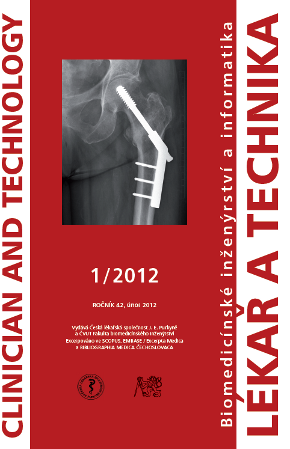MOŽNOST VYUŽITÍ POČÍTAČOVÉHO MODELOVÁNÍ PŘI ANALÝZE SPECIFICKÝCH KOMPLIKACÍ METODY DHS
Keywords:
dynamic hip screw, finite element method, specific complicationsAbstract
THE POSIBILITY OF COMPUTATIONAL MODELING USAGE IN THE SPECIFIC DYNAMIC HIP SCREW COMPLICATIONS ANALYSIS. The aim of the study was to determine the relationship between the specific complications and the dynamic hip screw (DHS) placement in the femoral neck with relation to finite element method analysis. Th eimplant associated specific complications are very diverse. We evaluated 336 dynamic hip screw osteosyntheses for pertrochanteric fractures in 324 patients. The program ABAQUS 6.9 was utilized for the development of the finite element model of the femur. Analyses were performed in 5 modeled situations corresponding to the screw location. Complication rate within the group of patients was 10 % in general, with a reoperation rate of 4 %. The highest risk of for an implant failure was associated with a location of the screw in the upper third of the neck. The finite element model analysis confirms our clinical experiences, when the optimal placement for a dynamic hip screw is in the middle third of the femoral neck. The technical mistake during the operation almost always leads to the implant failure with the need for the reoperation.Downloads
Published
Issue
Section
License
Copyright (c) 2017 Maroš Hrubina, Zdeněk Horák, Miroslav Skoták, Radek Bartoška, Valér Džupa

This work is licensed under a Creative Commons Attribution 4.0 International License.
Authors who publish with this journal agree to the following terms:
- Authors retain copyright and grant the journal right of the first publication with the work simultaneously licensed under a Creative Commons Attribution License (https://creativecommons.org/licenses/by/4.0/) that allows others to share the work with an acknowledgment of the work's authorship and initial publication in CTJ.
- Authors are able to enter into separate, additional contractual arrangements for the non-exclusive distribution of the journal’s published version of the work (e.g., post it to an institutional repository or publish it in a book), with an acknowledgment of its initial publication in this journal.
- Authors are permitted and encouraged to post their work online (e.g., in institutional repositories or on their website or ResearchGate) prior to and during the submission process, as it can lead to productive exchanges.
CTJ requires that all of the content of the manuscript has been created by its respective authors or that permission to use a copyrighted material has been obtained by the authors before submitting the manuscript to CTJ. CTJ requires that authors have not used any copyrighted material illegally, as for example a picture from another journal or book, a photo, etc. It is the author’s responsibility to use only materials not violating the copyright law. When in doubt, CTJ may ask the authors to supply the pertinent permission or agreement about the use of a copyrighted material.
The opinions expressed in CTJ articles are those of authors and do not necessarily reflect the views of the publishers or the Czech Society for Biomedical Engineering and Medical Informatics.


